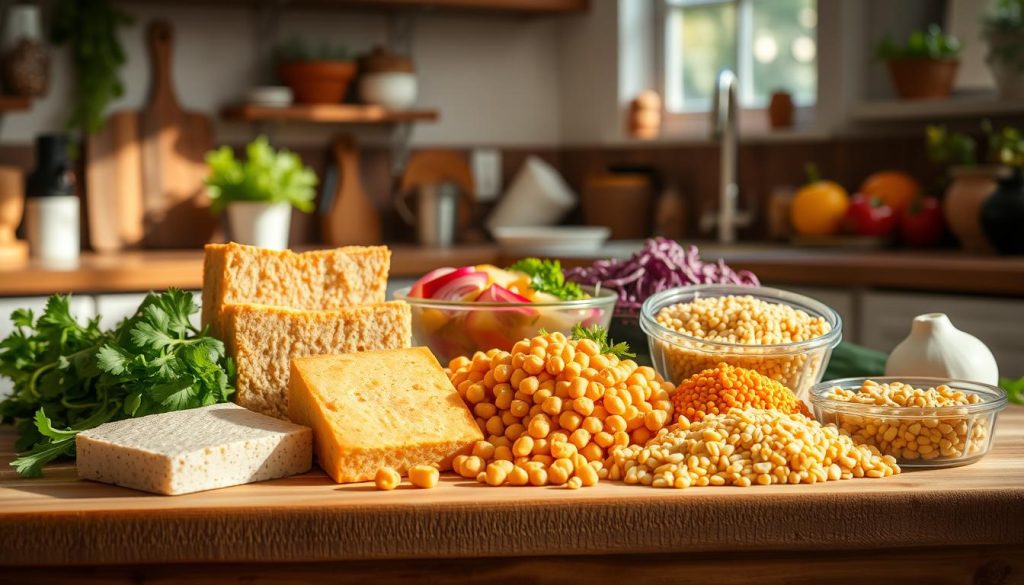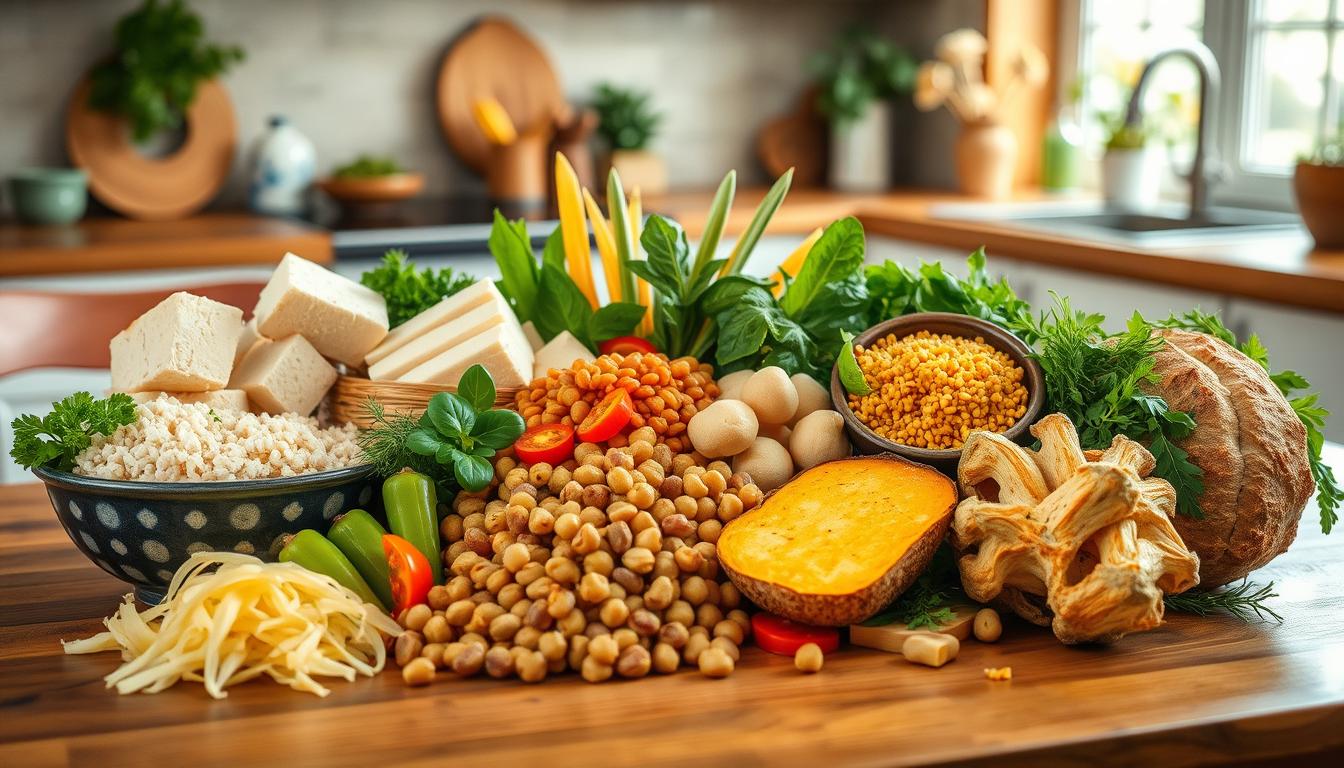Welcome to your ultimate tempeh substitute guide! Tempeh is known for being a versatile plant-based protein. It has about 18 grams of protein and 6 grams of fiber in every 3-ounce serving. This fermented soy product comes from Indonesia and is not only tasty but also good for you.
It can help lower cholesterol and reduce the risk of some cancers. As you look for vegan protein alternatives, this guide will help. You’ll find great options to replace tempeh in your favorite dishes. It’s all about keeping the flavor and nutrition while trying new plant-based proteins.
Understanding Tempeh and Its Nutritional Value
Tempeh is a fermented soybean product that’s rich in nutrients. It’s a key part of plant-based diets, known for its flavor and health benefits. Knowing where tempeh comes from and its health benefits can make you appreciate it more in your meals.
The Origins of Tempeh
Tempeh has been a staple in Indonesian cuisine for centuries. It’s made from fermented soybeans. Today, you can find it in various forms like blocks, crumbles, or strips. Adding tempeh to your diet connects you to its cultural roots and nutritional value.
Benefits of Including Tempeh in Your Diet
Tempeh is packed with about 15 grams of protein and 9 grams of carbohydrates in a 3-ounce serving. This makes it a great plant-based protein source. It’s also a good dairy-free option for calcium, with about two-thirds the amount in whole milk.
Tempeh is rich in vitamins and minerals like iron, magnesium, and riboflavin. The fermentation process adds probiotics, which are good for your gut. Eating tempeh can help lower cholesterol and support bone health, weight management, and fight oxidative stress.
Popular Tempeh Substitutes You Can Use
Looking for a tempeh substitute can make your meals better and healthier. Options like tofu, seitan, and legumes offer different tastes and benefits. Each can add something special to your dishes.
Tofu as a Versatile Alternative
Tofu has been a favorite in East Asia for over 2,000 years. It’s known for its mild taste and ability to soak up flavors. This makes tofu a great choice for those looking for tempeh alternatives.
Tofu comes in various textures, from soft to extra-firm. It’s perfect for many dishes. You can find it in blocks, squares, sheets, and ribbons. There’s even certified organic tofu, made from organic soybeans and can be GMO-free.
Seitan: The Wheat Gluten Wonder
Seitan comes from ancient China and is loved for its chewy texture. It’s like meat but absorbs sauces well, adding flavor to dishes. Seitan is also high in protein, making it a great choice for those who don’t eat meat.
Seitan can be used in many ways, like nuggets, patties, or crumbles. It’s a versatile option that’s good for those who don’t have gluten issues.
Legumes: Beans and Lentils for Protein
Legumes like lentils, chickpeas, and black beans are great for protein. They’re also high in fiber, making them excellent tempeh substitutes. You can add them to salads, stews, or tacos.
Legumes are easy to use in many recipes. They bring a lot of nutrition to your meals. Adding them to your diet can make it healthier and more flavorful.

Tempeh Substitute Guide: How to Choose the Right Option
Choosing the right tempeh substitute is about knowing what you need in your cooking. Each option has its own nutritional benefits and taste. It’s key to think about these when picking a substitute.
Factors to Consider When Choosing a Substitute
When picking tempeh substitutes, look at these points:
- Recipe Requirements: Think about the taste and texture you want. Tofu is great for creamy dishes, while seitan works well for chewy ones.
- Nutritional Needs: Check the protein content. Seitan, for example, has about 25 grams per ⅔ cup, similar to chicken.
- Dietary Restrictions: Think about any dietary needs. Legumes, like beans, are nutritious and affordable.
- Personal Preferences: Your taste matters. Some like tempeh’s nutty taste, while others prefer tofu’s mildness.
Flavor Profiles and Cooking Techniques
Substitutes come in different flavors, letting you get creative in the kitchen. Here’s a quick guide:
| Substitute | Flavor Profile | Cooking Techniques |
|---|---|---|
| Tofu | Mild, adaptable | Grilling, baking, sautéing |
| Seitan | Meat-like, chewy | Stir-frying, frying, grilling |
| Legumes | Earthy, hearty | Stewing, roasting, boiling |
| Tempeh | Nutty, mushroomy | Steaming, sautéing, baking |
Using the right cooking methods can make plant-based proteins taste better. For instance, frying tofu makes it crispy, while steaming tempeh keeps it moist. Knowing these tips can make your dishes more appealing.

Creative Ways to Incorporate Substitutes into Your Meals
Adding creative substitutes to your meals can change your cooking game. Tofu and seitan are great for making tasty dishes. Legumes add protein and fiber, making your meals healthy and filling. Start exploring recipes to begin your cooking adventure.
Recipes Featuring Tofu and Seitan
Tofu and seitan are perfect for many dishes. Here are some easy and tasty recipes:
- Tofu Stir-Fry: Sauté firm tofu with colorful veggies and your favorite sauce for a quick meal.
- Seitan BBQ Sandwiches: Marinate and grill seitan for a hearty sandwich, great for summer barbecues.
- Spicy Tofu Tacos: Mix tofu with spices and serve in taco shells with fresh salsa.
Using Legumes in Stir-Frys and Salads
Legumes make your meals special. They add flavor and texture:
- Chickpea Salad: Mix canned chickpeas with diced veggies and a zesty lemon dressing for a refreshing salad.
- Lentil Stir-Fry: Add cooked lentils to a stir-fry with veggies and spices for a filling meal.
- Black Bean Tacos: Use mashed black beans as the filling for tacos, with avocado and cilantro for extra taste.
| Dish | Main Ingredient | Proteins | Cooking Method |
|---|---|---|---|
| Tofu Stir-Fry | Firm Tofu | 19g per 100g | Sauté |
| Seitan BBQ Sandwich | Seitan | 75g per 100g | Grill |
| Chickpea Salad | Canned Chickpeas | 19g per 100g | No-cook |
| Lentil Stir-Fry | Lentils | 9g per 100g | Sauté |
Trying these recipes will improve your cooking skills and make your meals healthier. Experiment with these recipes to find new flavors and enjoy a balanced diet.
Conclusion
In this summary, we looked at tempeh and its substitutes. We found that tofu, seitan, and legumes are great for plant-based diets. They add variety to your meals and let you try new flavors and textures.
Using these protein-rich options makes your diet more interesting. Tempeh, for example, has 18 grams of protein and 4 grams of fiber. It also has vitamins that are good for your health. Adding these to your meals can make you feel full and keep your body healthy.
Plant-based diets are becoming more popular. Try adding these alternatives to your meals. You’ll enjoy delicious food and live a healthier life, full of nutrients that are good for you.
Source Links
- https://rainbowplantlife.com/guide-to-tempeh/
- https://www.thymetogovegannutritionservices.com/tempeh-cooking-guide/
- https://www.eatingbirdfood.com/tempeh-recipes/
- https://www.healthline.com/nutrition/tempeh
- https://www.webmd.com/food-recipes/tempeh-health-benefits
- https://foodprint.org/blog/traditional-meat-alternatives/
- https://www.healthierforlife.com/library/the-ultimate-guide-to-plant-based-meat-substitutes
- https://theultraviolet.com/21538/news-blogs/a-guide-to-plant-based-meat-alternatives/
- https://www.simplyquinoa.com/what-is-tempeh/
- https://www.bmc.org/nourishing-our-community/teaching-kitchen/substitution-guide
- https://www.plantbasedcooking.com/plant-based-recipe-substitutions/
- https://essycooks.com/tempeh-health-benefits-how-to-cook-and-eat/
- https://wiser.eco/tempeh-nutrition-and-recipe/
- https://casadesante.com/blogs/vegan/the-ultimate-guide-to-finding-and-using-tempeh-where-to-buy-and-creative-recipes?srsltid=AfmBOop7FNtdYJwTic92UyFSOxlVd0XbCtk6heCoL6BmfHRegqb_Rpkd
